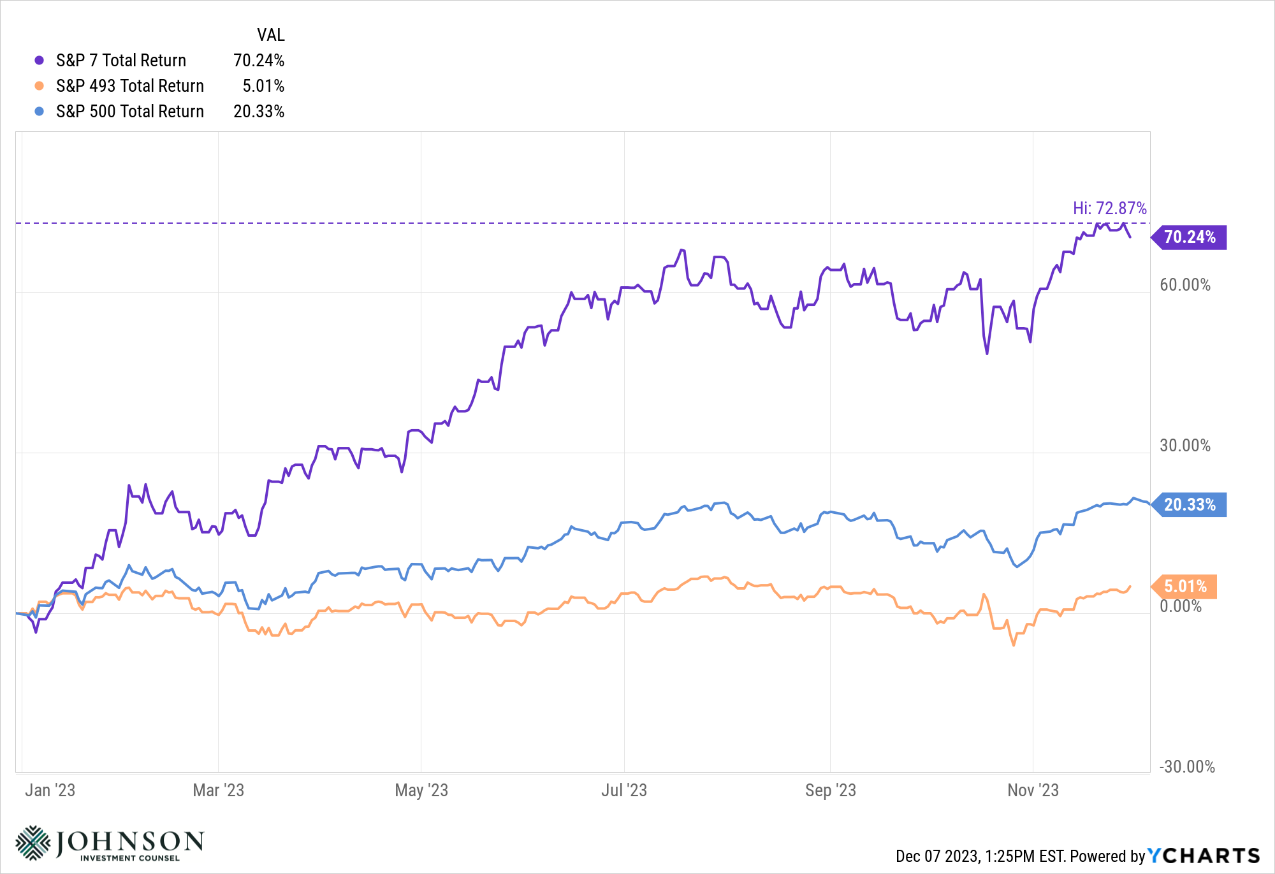
As we close 2023 and flip the calendar to 2024, we can look back at generally strong markets in the face of economic and geopolitical uncertainty. To start the year, several economic indicators were already trending negative while the Fed proceeded with aggressive rate hikes to steamroll inflation. It’s easy to see why many prognosticators were predicting recession this year. However, as of mid-December, it appears we have avoided one of the most predicted economic contractions ever. Moving into 2024, economic storm clouds are still on the horizon, but in the coming year, markets will have to digest a presidential election that will undoubtedly be undecided until late in the year, which will leave tax, fiscal, economic, and regulatory policy up in the air.
But all these factors and scenarios have one thing in common: they are out of our control. Realizing this, we believe there are few financial “checklists” and tactics we actually do control which could have a tangibly positive effect on cash flow, balance sheets, and peace of mind.
Investment Portfolio Checklist
- Re-asses Risk Appetite: Whether we realize it or not, we have witnessed historic shifts in monetary policy the last two years with the Federal Reserve’s aggressive increases in the Fed Funds rate. While that may seem somewhat wonky, these changes had very real and very severe impacts on fixed income holdings, which endured the worst returns in decades. This was especially jarring to many because fixed income has traditionally been tagged as the “safe” asset in an allocation. Prior to 2022, a bad year in fixed income was a 2% decline – much less severe than the double-digit percentage declines across many bond markets in 2022. Enduring this decline was a great litmus test for the ability to stay true to the allocation and trust the historic nature of markets eventual recoveries, which we’re just now starting to see. On the other hand, if a fire-sale was executed during these scary times, it’s probably a good indicator that risk appetite is not aligned with reality. Perhaps a more risk-averse portfolio makes sense in the years to come to prevent locking in losses with panic sales and permanently impairing a family’s wealth plan.
- Revisit Fund & Asset Allocation: As most know, the biggest winners in the US large cap stock market this year were large US technology names, which have disproportionately contributed to the strong S&P 500 returns thus far in 2023. As of mid-December, the “Magnificent 7” (Facebook, Amazon, Alphabet (Google), Apple, Tesla, NVIDIA, and Microsoft) represent about 28% of the 500 stocks in the S&P 500 and were up 70% year-to-date while the “other 493” stocks are up only 5%. This isn’t the first time we’ve experienced such a “top heavy” market, and, using history as our guide, it’s likely these 7 names could revert to the mean and underperform the broader market at some point. Even though these are great and profitable companies, this might be a good time to ensure portfolio exposure isn’t too heavily weighted to such a small number of companies -- either with holdings of individual shares or within the context of an index or tech heavy mutual fund or ETF. /ul>

- Check for Idle Cash: A silver lining to the higher interest rates is, of course, the opportunity to actually earn interest on savings and money market accounts. Having cash “collect dust” in accounts without earning interest wasn’t a big deal when these accounts were paying 0.01% per year. However, with money markets, CDs, and some savings accounts paying 4% or more, leaving cash in low-interest accounts is leaving real money on the table.
- Calculate Employer Stock Exposure: Similar to overexposure to the Magnificent 7, anyone whose compensation includes some form of company stock (directly or through 401(k) matching) should check for overexposure to employer stock. Working for a great and successful company is a blessing, but overexposure to the success or failure of an employer can come it two forms: a paycheck and equity holdings. In general, limit such exposure to 5-7% of net worth if possible, and if higher, consider paring down and diversifying these positions to maintain a well-diversified portfolio.
Tax Planning Checklist:
- Harvest Capital Losses in Taxable Accounts: Before year end, revisit taxable investment accounts and consider selling positions with unrealized losses. Doing so can reduce, or even completely offset, realized capital gains income, and if higher than income, deduct up to $3,000 in losses. It’s also a good idea to refer to last year’s tax return to look for capital loss carryforwards that can be used in the current tax year.
- Consider Year-End Catchup Contributions to Max Out Retirement and Health Savings Accounts: Different retirement plans have different deadlines, but in general, contributions to employer-based plans (i.e. 401(k)) are constrained to the calendar year. So, before year end, check to see if there’s still “room” to contribute and reduce taxable income. For a 401(k), employees can contribute up to $22,500 in 2023, and if over 50 years old, an additional $7,500 can be contributed. For IRAs, it’s $6,500 and $7,500 for those over 50. For individual IRAs and some other plans for the self-employed (Solo 401k, SEP, SIMPLE), this deadline is generally before the tax filing date in April 2024.
- Check Mutual Funds in Taxable Accounts for Upcoming Distributions: Before year end, mutual funds will publish expected capital gains distributions, which could be paid out as capital gains before the end of 2023. When this happens so late in the year, there is little to be done to offset this gain, which may cause higher taxable income. This is a good time to check your fund holdings in taxable accounts to estimate how much, if any, will be paid out as taxable capital gains income before year end.
- Think Charitably:
- If a taxable account contains some “winners” from the aforementioned big tech melt up and one is charitably inclined, this could be a good year to open or fund a Donor Advised Fund with these low-basis holdings. (Note: donating appreciated shares requires the shares held for one year to maximize deductibility of the value.) Donating appreciated stock from taxable accounts comes with two benefits: the tax deduction on the amount of the gift and the ability to avoid paying capital gains tax on those positions in the future. (Note: Deductibility assumes itemizing deductions.)
- Consider using Qualified Charitable Distributions (QCDs) from an IRA if age 70 ½ or older. This can reduce taxable income associated with RMDs without having to itemize deductions. It also utilizes tax-deferred assets for charity (instead of liquid cash) and lowers the IRA balance, thereby lowering future taxable RMDs.
- Do the Math on Roth Conversions: We are always on the lookout for low-income years, especially with recent retirees entering what we call The Golden Window of Tax Planning in our blog from 2021. We believe this time period, after retirement but prior to RMDs and Social Security claiming, is a great time to leverage the low-income year to “fill up” the lower rate tax brackets by converting a portion of tax deferred assets to a Roth IRA and paying the lower rate. These “low income” years could be an opportunity to voluntarily pay lower rates on the converted funds as future RMDs loom. For additional detail, check out our blog from May 2020 which dives in to the advantages, disadvantages, and pitfalls of such a strategy.
Estate Planning Checklist
- Review Beneficiary Designations and Asset Titling: The most basic estate planning practice is as simple as ensuring the beneficiaries on various accounts are up-to-date and accurate. Simply making a list of accounts and confirming the appropriate primary and contingent beneficiaries can be the foundation of any well-structured estate plan. Without these simple designations, these accounts could require administration through probate court after the account owner’s death. Probate court costs, delays, and administrative headaches are an unwelcome surprise in what is already a difficult time for those dealing with the death of a loved one.
- Revisit the Roles in the Estate Plan: In addition to beneficiary designations, it’s also a good idea to revisit who is listed in the various roles in estate planning documents. These roles can include a trustee for a trust, an executor for a will, and agents for health care power of attorney or durable (financial) power of attorney. Are these people still willing and able to serve these roles? Do you still have a trusting relationship? Are they still alive? Updating these names is a simple process that can avoid big headaches upon death.
- With Trusts & IRAs, Consider A Meeting with Your Estate Planning Attorney: In what seems like ancient history, the SECURE Act (passed in December 2019) limited the ability to “stretch” distributions of inherited IRAs. This could have impaired a well-thought-out estate plan with respect to trusts, so it’s a good idea to consult with an attorney on how the plan may have been impacted by this new law. For additional detail, check out our blog from January 2020.
Retirement Reality Check
- Spending vs. Assets: In the simplest of terms, potential retirees need to know if their assets will fund their spending and legacy goals. Of course, this requires a deep dive into spending pace, market assumptions, appropriate asset allocation, retirement income analysis, and tax analysis. Taking a fresh, and brutally honest, look at spending could be the most important step a family can take when assessing their retirement readiness. For most, it’s tedious and frustrating to track down all the bills and spending, but spending relative to assets, in our opinion, is the single most impactful predictor of a successful retirement.
- Re-Prioritize Our Time: The close of the calendar year and the fresh start to the new year is a great time to reassess priorities and value of our most limited yet unknowable asset: our time. For many, a lifetime of working, saving, raising kids, and building a career or business could have resulted in substantial assets and retirement income. Instead of thinking of retirement as “someday,” is it time to finally get clarity on exactly when and how retirement can be a reality? The most impactful realization might be recognizing the value of our time and how the most valuable time we have could be our remaining years to spend with friends & family.
Published 12/19/2023
Johnson Investment Counsel, Inc. (“JIC”) is an independent and privately owned investment advisory firm registered with the Securities and Exchange Commission. This material has been prepared for informational purposes only, and is not intended to provide, and should not be relied on for, tax, legal or accounting advice. You should consult your own tax, legal and accounting advisors prior to taking any action. Some of the comments, scores and probabilities in this presentation are based on current management expectations and are considered “forward-looking statements”. Actual future results, however may prove to be different from our expectations. Our opinions are a reflection of our best judgment at the time this presentation was created, and we disclaim any obligation to update or alter forward-looking statements as a result of new information, future events or otherwise. To determine if the strategy presented is appropriate for you, carefully consider the investment objectives, risk factors, and expenses before investing. Individual account management and construction will vary depending on each client’s investment needs and objectives.